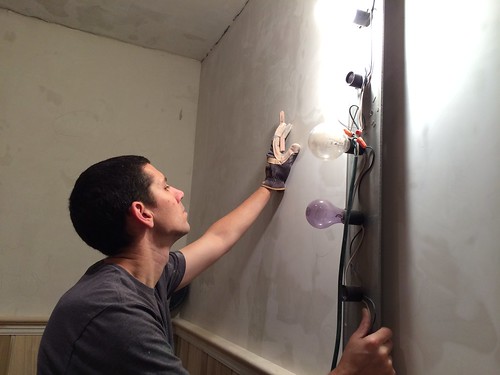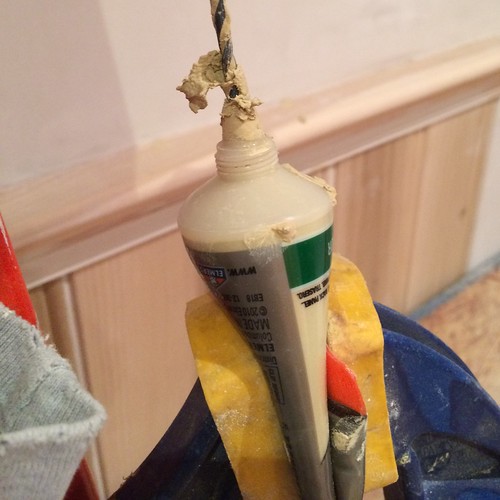Amidst this past long holiday weekend's marathon of moderate gluttony spliced with periods of recovery, which most often resembled one or both of us wallowing like a beached whale, we were fortunate to experience a Thanksgiving with several wonderful friends and excellent food. Sprinkle in some unabashed consumerism, a ceremony to flick the switch on a tree covered in lights, and the unfortunate need to interrupt the preferred holiday and weekend's events with day job drudgery (being an adult stinks), and you've got yourself a recipe for much of our last several days. But I'd be foolish if I left off our attempts to work as much as possible on our ongoing house projects.
That's right, we continued on our seemingly endless march of tasks in the bathroom and our attempts to produce crisp clean walls and beautiful ceilings. At a certain point the incessant sanding begins to feel like I'm fully entrenched and have become some sort of a maniacal sanding savant, but unlike Dustin Hoffman's character in Rain Man, whose useful character trait was counting cards in Vegas, I have this particular aptitude for sanding compulsively until the walls are smooth. Wow, what a gift.

Like my makeshift bright light for spotting sanding imperfections?
However non stop the sanding had been, it's not only been limited to the walls but also involved the countless dots of wood filler we've been placing on all of the small nail holes in wainscoting, trim, and crown moulding throughout the room.
Ah, wood filler, the putty like material that's nearly driven me—out of a level of frustration that only ever mounts at this stage of a project—to commit heinous acts. If there are two things I'm rather sure of in my life as a DIYer it's:
- Wood filler seems incredibly simple to work with until you actually begin working with it.
- I'm certain I'm doing it wrong.
While I've known the first fact for some time, my recent realization of this second nugget of wisdom came only recently. It wasn't until I had grown so angry at my tube of wood filler that I grabbed several clamps and placed it, balled up, within what appeared to be a medieval torture mechanism of some sort. No, the tube wasn't charged with public drunkenness, spreading lies, or baking bread that was too small (all things that would get you tortured in medieval times), its crime was simple. This stupid tube of wood filler had clogged yet again.
I posted my wood filler torture on Instagram where other renovators commiserated on the propensity for tube based wood filler to dry prematurely, leaving the user confused at what went wrong.
This made me take stock of my entire wood filler process to determine the error of my ways. The results of my assessment? A resounding "whole lot."
It all starts with my initial purchase. When I pick up the tube based filler I apparently take a first significant misstep that will almost surely bring me long term frustration. There's something about the tube's design that causes it to dry at the tip roughly three minutes after removing the cap, leaving you with a tube that's full of useful wood filler guarded by a hardened defense more capable than the ferocious wizardry and mountains surrounding Mordor.
Once I get to the point where I'm equal parts squeezing out the wood filler and swearing uncontrollably, I seem to be still doing it wrong. Since the tube is no longer easily manipulated I'm not squeezing out wood filler directly onto the exposed holes, but instead squeezing it only my finger.
When my finger becomes the most effective delivery mechanism for the mixture of dry and wet filler I was able to coerce from its sarcophagus-like tube dwelling, I feel the intended design has failed, but I could be completely wrong here. I don't know, I'm just flying in the dark at this point.
By the time the filler is caked onto my fingers I begin smearing it into the various voids where this wood filler will take residence, moderately to significantly over filling the hole to ensure there are no voids left once it's all removed.
I repeat this step time and again, slowly moving around the room. As each of my clean fingers becomes unusably soiled with the filler, creating more of a mess than the intended filling of holes, I move onto a clean finger, from my thumb to my pinky.
When the wood filler would not move, no matter how much pressure I applied with mechanical devices, I would employ a "drill baby, drill" approach, using a long drill bit to coerce the filler to the surface. At one point, with enough pressure applied, and the drill bit dislodging just enough wood filler, a veritable explosion tends to occur, sending splatters of wood filler as miniature projectiles eight or more feet through the air at a rather high rate of speed. Who knew you needed to wear eye protection when using wood filler?
This has been my pattern for years, but my level of frustration reached a boiling point this past weekend. Rather than continue to fume at the fallible function of the frozen filler funnel I turned to the ways of a mad surgeon. Fed up, I grabbed my utility knife and turned our work zone into a makeshift operating theater, performing an advanced level of open chest surgery on the wood filler tube. I sliced the filler down the middle and gave myself a door to the perfectly preserved treasure trove of wet and pliable wood filler.
Although I had completely destroyed the intention of the wood filler tube, I didn't care. I was finally able to freely move around the room taking as much filler as necessary and applying (via finger) to the intended target. I didn't care that my tube was defunct and would not be useful past the conclusion of the evening. I had overcome the horrible design in a rage of wastefulness and I both hated and loved myself for taking the bull by the horns. It gave me a scary level of satisfaction to know I had both freed the wood filler from its tomb and killed the delivery vessel I now despise.
From this point forward I plan on purchasing only the wood filler in a can or tub. I've sworn off the tube based filler that I originally believed was such a good idea. My stubbornness caused me to continue to buy this inferior product as I feared it was more user error than design flaw. But today, I say to you, I am a changed man. I see the follies of my ways and will not make this same mistake again. Onward and upward, I will not be tortured by a tube spout clogged by a dry stone of filler any longer.
That being said, I still have that pesky issue with using my fingers to apply wood filler. But is that so wrong? Is there a better way to do it? If so, can you show me the way?

![]()
![]()